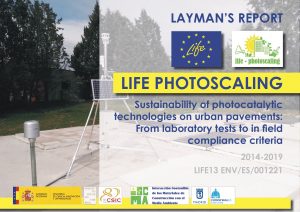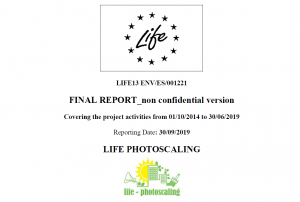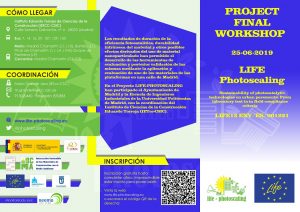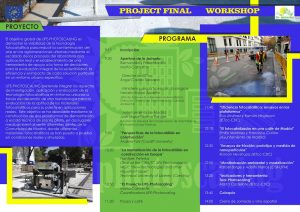PROJECT
LAYMAN’S REPORT
Check out the Layman’s Report of LIFE PhostoScaling Project in this link.
|
FINAL REPORT
Check out the Final Report (non-confidential version) of LIFE PhostoScaling Project in this link.
|
PHOTOSCALING DECISION MAKER AVAILABLE + USER’S MANUAL
The LIFE Photoscaling Decision Maker shown at Project Final Workshop is available in this link.
The User’s Manual is available to download by clicking in this link.
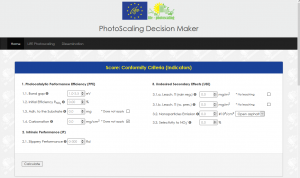
From the analysis carried out on the behaviour of the different materials in the platforms and the results obtained in the laboratory tests related to the relevant aspects, 3 main indicators have been recognized:
1) Photocatalytic Performance Efficiency (PPE)
2) Intrinsic performance (IP)
3) Undesired Secondary Effects (USE)
Within each of these three indicators, several sub-indicators have been identified. For each of the indicators, those are:
1: Photocatalytic Performance Efficiency (PPE)
-
- 1-1.a: Band gap (eV)
- 1-1.b: Position of the bands (V)
- 1-2: Initial efficiency NOx (ISO 22197-1:2007); RNOx (%)
- 1-3: Adherence to the substrate
- 1.4: Carbonation
2: Intrinsic performance (IP)
-
- 2-1: Slippery:
3: Undesired Secondary Effects (USE)
-
- 3-1: Leaching of Ti (2 methods)
- 3-2: Nanoparticles emission as airborne
- 3-3: Selectivity to NO3–
In order to make the scoring of the products, each sub-indicator has been classified in four categories, divided according to an incremental favorable significance. For each sub-indicator, the worst category has been assigned 1 point, 2 for the medium one, 3 points for the following and 4 points for the more favorable results of the method. Additionally, if the value obtained in one of the tests is considered that makes the product not feasible to be installed in the street, a 0 has been assigned. If a product has been given a 0 in any of the sub-indicators, that product is rejected.
Within each group of indicators, it possible to assign different weighs to the different sub-indicators if it is considered that one of them has to count more in the final score for the indicator. As a first step, the sum of the points of the different sub-indicators corresponding to each indicator is divided by the total points available for that indicator; that gives the score/indicator. For example a material having the maximum punctuation (6 points for a total of 6) will have “100%” for that indicator.
Then, the score/indicator is multiplied by a factor of importance, I.F., that depends on the weight that the indicator is considered to have.
A summary of the indicators, sub-indicators and ranges for scoring is given in the following table:
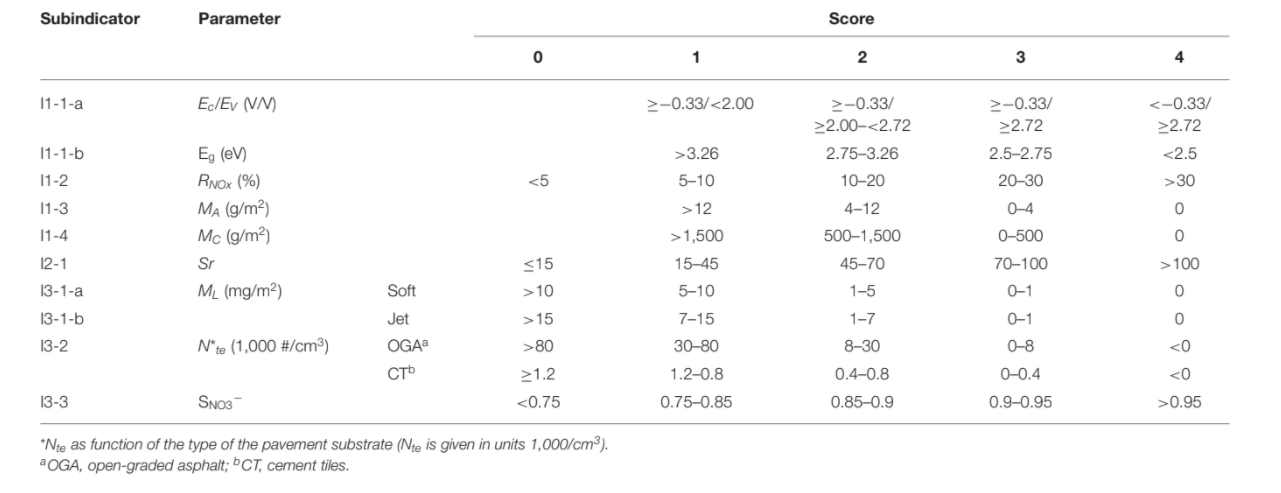 A summary of the Importance Factor for indicators and subindicators is given in the following table:
A summary of the Importance Factor for indicators and subindicators is given in the following table: We want your help in defining ranges and IF for the Photoscaling Decision Maker . Please, give your comments below or sent us an email at life-photoscaling@ietcc.csic.es (tell us your name, surname, institution and email).
We want your help in defining ranges and IF for the Photoscaling Decision Maker . Please, give your comments below or sent us an email at life-photoscaling@ietcc.csic.es (tell us your name, surname, institution and email).
PROJECT FINAL WORKSHOP
The last 25th of June, at Institute Eduardo Torroja, we celebrated the LIFE-Photoscaling Final Workshop. There, attendants saw the whole processes of investigation from the beginning of the project, the tests performed, every studied material and several interesting things.
All the videos with the presentations can be watched here.
Programme (click in each image):
…
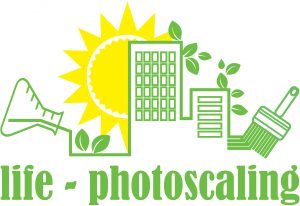
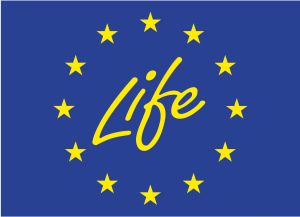
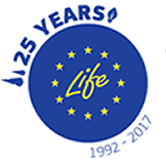
25 years of EU supporting
Nature, Environment and Climate Action through.
Celebration event in this link.
LIFE-PHOTOSCALING’s global objective is to demonstrate the validity of the photocatalytic technology in urban agglomerations, establishing the instruments to scaling up from laboratory measurements to application in our cities, by developing a decision support tool, to assess the sustainability of each particular solution in each particular environment to encourage the widespread use of this technology.
Some attempts have been made in order to apply this technology in a real scale. However, in those cases important problems were encountered to monitor the system from a global point of view that makes it very difficult or even impossible to evaluate if the technique is really working. That is why there is still a barrier that discourages public authorities and most architects and engineers to promote the use of this technology, together with the fact that there is not any compliance criterions’ concerning neither activity nor durability or possible secondary effects.
Therefore, LIFE-PHOTOSCALING intends to bridge the gap between research, policy and widespread implementation of the technology. Their global objective will be met through the following partial objectives:
1: Development of two demonstration platforms (same materials, different emplacements) on an intermediate pilot plant technical scale.
2: Technical development of a prototype for in-situ measuring the photocatalytic efficiency.
3: Development of performance indicators for evaluation of the:
- Photocatalytic efficiency
- Durability of the material itself concerning their intrinsic properties.
- Evaluation of the possible unwanted deleterious effects.
4: Modelling of the photocatalytic processes coupled with the environmental actions.
5: Development of a decision support tool, to undertake the sustainability of each particular solution including a life cycle assessment (LCA).
6: Validation of the tool developed in real –full scale- conditions.
7: Breaking the barriers to the implementation of this technology after having probed safe for human health: communication of the lessons learnt and standardisation efforts.
These objectives would contribute to the implementation of the EU environmental policy and legislation, specified as the objectives and priority areas of the 6th EAP and in the actions and contaminants targeted as priorities in the Thematic Strategy on air pollution, that are those to be reduced by applying photocatalytic technology.

